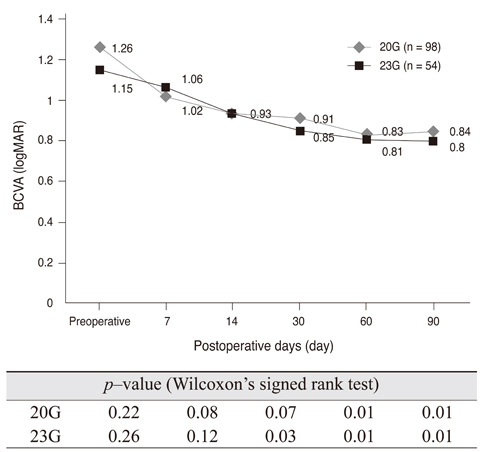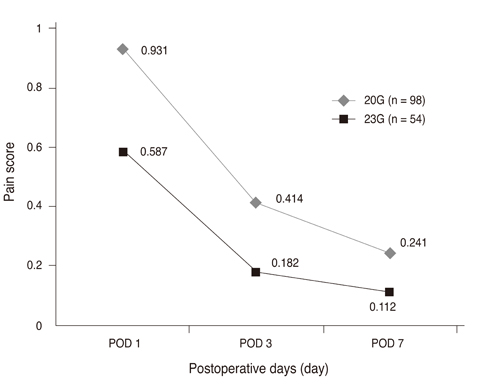Korean J Ophthalmol.
2013 Feb;27(1):12-18. 10.3341/kjo.2013.27.1.12.
Comparison of the 20-Gauge Conventional Vitrectomy Technique with the 23-Gauge Releasable Suture Vitrectomy Technique
- Affiliations
-
- 1Department of Ophthalmology, Maryknoll Hospital, Busan, Korea. pjm1438@hanmail.net
- 2Department of Ophthalmology, Haeundae Paek Hospital, Busan, Korea.
- KMID: 1501790
- DOI: http://doi.org/10.3341/kjo.2013.27.1.12
Abstract
- PURPOSE
To compare the efficacy of the transconjunctival releasable suture technique for pars plana vitrectomy using 23-gauge (23G) instruments versus the conventional 20-gauge (20G) technique.
METHODS
A retrospective and interventional case series was consecutively performed for 199 eyes of the 192 patients that were a part of this study. Clinical data were reviewed retrospectively regarding the operation time, preoperative and postoperative intraocular pressure, visual acuity and astigmatism for 54 consecutive patients who received a 23G releasable suture vitrectomy and for 98 consecutive patients who received a 20G conventional vitrectomy during the period between April 2007 and September 2010.
RESULTS
Mean operation time based on the operation record was 88.5 +/- 20.1 minutes in the 23G releasable suture vitrectomy group and 102.1 +/- 23.1 minutes in the 20G conventional vitrectomy group, respectively (p = 0.01). The last best-corrected visual acuity (BCVA) was significantly better than the preoperative BCVA in both patient groups (p = 0.01, p = 0.01). The 23G releasable suture group showed less surgically induced astigmatism than the 20G conventional vitrectomy group. Vitreous bleeding was observed to be in 6 eyes (5.9%) in the 23G group, and in 8 eyes (8.2%) in the 20G group. In addition, ocular hypertension was noted to be in 3 eyes (3.0%) in the 23G group, and 6 eyes (6.1%) in the 20G group. No serious complications such as postoperative hypotony or endophthalmitis were observed in either group.
CONCLUSIONS
The 23G releasable suture technique is as effective as the 20G conventional technique and offers several advantages.
Keyword
MeSH Terms
Figure
Reference
-
1. Eckardt C. Transconjunctival sutureless 23-gauge vitrectomy. Retina. 2005. 25:208–211.2. Jackson T. Modified sutureless sclerotomies in pars plana vitrectomy. Am J Ophthalmol. 2000. 129:116–117.3. Assi AC, Scott RA, Charteris DG. Reversed self-sealing pars plana sclerotomies. Retina. 2000. 20:689–692.4. Morlet N, Minassian D, Dart J. Astigmatism and the analysis of its surgical correction. Br J Ophthalmol. 2001. 85:1127–1138.5. Chen JC. Sutureless pars plana vitrectomy through self-sealing sclerotomies. Arch Ophthalmol. 1996. 114:1273–1275.6. Milibak T, Suveges I. Complications of sutureless pars plana vitrectomy through self-sealing sclerotomies. Arch Ophthalmol. 1998. 116:119.7. Kwok AK, Tham CC, Lam DS, et al. Modified sutureless sclerotomies in pars plana vitrectomy. Am J Ophthalmol. 1999. 127:731–733.8. Wimpissinger B, Kellner L, Brannath W, et al. 23-Gauge versus 20-gauge system for pars plana vitrectomy: a prospective randomised clinical trial. Br J Ophthalmol. 2008. 92:1483–1487.9. Kadonosono K, Yamakawa T, Uchio E, et al. Comparison of visual function after epiretinal membrane removal by 20-gauge and 25-gauge vitrectomy. Am J Ophthalmol. 2006. 142:513–515.10. Weinberger D, Lichter H, Loya N, et al. Corneal topographic changes after retinal and vitreous surgery. Ophthalmology. 1999. 106:1521–1524.11. Azar-Arevalo O, Arevalo JF. Corneal topography changes after vitreoretinal surgery. Ophthalmic Surg Lasers. 2001. 32:168–172.12. Slusher MM, Ford JG, Busbee B. Clinically significant corneal astigmatism and pars plana vitrectomy. Ophthalmic Surg Lasers. 2002. 33:5–8.13. Bergmann MT, Koch DD, Zeiter JH. The effect of scleral cautery on corneal astigmatism in cadaver eyes. Ophthalmic Surg. 1988. 19:259–262.14. Wirbelauer C, Hoerauf H, Roider J, Laqua H. Corneal shape changes after pars plana vitrectomy. Graefes Arch Clin Exp Ophthalmol. 1998. 236:822–828.15. Gupta OP, Maguire JI, Eagle RC Jr, et al. The competency of pars plana vitrectomy incisions: a comparative histologic and spectrophotometric analysis. Am J Ophthalmol. 2009. 147:243–250.e1.16. Ooto S, Kimura D, Itoi K, et al. Suprachoroidal fluid as a complication of 23-gauge vitreous surgery. Br J Ophthalmol. 2008. 92:1433–1434.17. Sabti K, Kapusta M, Mansour M, et al. Ultrasound biomicroscopy of sclerotomy sites: the effect of vitreous shaving around sclerotomy sites during pars plana vitrectomy. Retina. 2001. 21:464–468.18. Taban M, Sharma S, Ventura AA, Kaiser PK. Evaluation of wound closure in oblique 23-gauge sutureless sclerotomies with visante optical coherence tomography. Am J Ophthalmol. 2009. 147:101–107.e1.19. Chen D, Lian Y, Cui L, et al. Sutureless vitrectomy incision architecture in the immediate postoperative period evaluated in vivo using optical coherence tomography. Ophthalmology. 2010. 117:2003–2009.20. Song Y, Shin YW, Lee BR. Adjunctive use of a novel releasable suture technique in transconjunctival vitrectomy. Retina. 2011. 31:243–249.21. Parolini B, Prigione G, Romanelli F, et al. Postoperative complications and intraocular pressure in 943 consecutive cases of 23-gauge transconjunctival pars plana vitrectomy with 1-year follow-up. Retina. 2010. 30:107–111.22. Lee BR, Song Y. Releasable suture technique for the prevention of incompetent wound closure in transconjunctival vitrectomy. Retina. 2008. 28:1163–1165.23. Woo SJ, Park KH, Hwang JM, et al. Risk factors associated with sclerotomy leakage and postoperative hypotony after 23-gauge transconjunctival sutureless vitrectomy. Retina. 2009. 29:456–463.24. Gupta OP, Weichel ED, Regillo CD, et al. Postoperative complications associated with 25-gauge pars plana vitrectomy. Ophthalmic Surg Lasers Imaging. 2007. 38:270–275.
- Full Text Links
- Actions
-
Cited
- CITED
-
- Close
- Share
- Similar articles
-
- Initial Experience With 20-Gauge Transconjunctival Sutureless Vitrectomy Using Conventional Instruments
- Comparison Between 20-Gauge and 23-Gauge Vitrectomy System in Primary Vitrectomy for Rhegmatogenous Retinal Detachment
- Comparison of Silicone Oil Removal Using 23-Gauge and 20-Gauge System for Pars Plana Vitrectomy
- Sclerotomy-related Retinal Breaks in Vitrectomy for Proliferative Diabetic Retinopathy: 20- vs 23-Gauge Systems
- Comparison of Efficacy and Safety between Transconjunctival 23-Gauge and Conventional 20-Gauge Vitrectomy Systems in Macular Surgery




